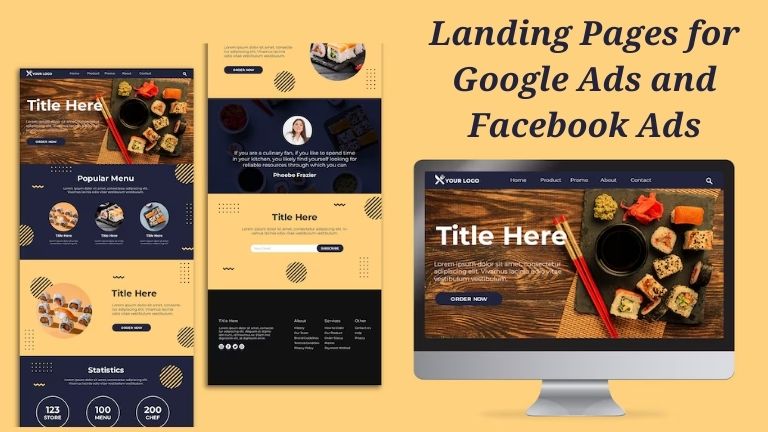
Writing a high-converting landing page is essential if you want to turn visitors into leads or customers from your Google Ads and Facebook Ads campaigns. With a proper landing page, you ensure that your ad spend isn’t wasted, resulting in a better ROI. This blog will cover the significance of landing pages, how to create high-quality Facebook and Google Ads, and the associated effective landing page design guidelines for each platform.
The Importance of Landing Pages
In online marketing, a landing page is a standalone web page created specifically for an advertising or promotional campaign. It has a single focus, known as a call-to-action (CTA). Below, we will look at the importance of landing pages:
- Higher Conversion Rates: Personalized landing pages contain a simple and succinct message and CTA, which in turn improves conversion rates.
- User Experience: Landing pages provide a seamless user experience by delivering the exact content that customers anticipate.
- Increased Profitable Ad Performance: Platforms like Google and Facebook reward better ad performance with reduced advertising costs and improved rankings.
- Data Collection: Landing pages can be optimized for lead capture, providing rich customer data for future marketing efforts.
- Clear Messaging: Landing pages eliminate distractions from other parts of the site, keeping users focused on converting.
Also Read About Build your landing page in minute with our tool
Step-by-Step Guide to Making a High-Converting Landing Page for Facebook Ads
- Goal: Define what you are working for a landing page. Whether that’s capturing leads, selling a product, or getting sign-ups.
- Consonance in Content: Establish that the landing page contents and their web pages are a reflection as to what audience your Facebook ad campaign focuses on.
- Attention-Grabbing Headline: Your headline should stand out and include value proposition.
- Engaging Visuals: Post high-quality images or videos that are both on-brand and attractive to the audience.
- Clear CTA: Your call to action should be clear or specific and in-your-face. Include language like “Sign Up Now,” “Get Started,” or “Download Free Guide.”
- Social Proof: Testimonials, reviews & case studies to show you are credible and re-inforce trust.
- Mobile Optimization: While a hefty portion of Facebook users uses it with their mobile devices, Make your landing page is compatible for all kind of Mobile viewing.
- Nothing to Distract: Eliminate extra links, navigation bars taking people away from what they are there to do.
Also Read About Different types of landing pages
Framework Example:
- Title: “Get FREE Access to Members-Only Deals!”
- Subheadline: Join thousands of satisfied customers & save hundreds on your next purchase
- Images: Picture of smiling customers enjoying your product.
- CTA Button: “Join Now and Save”
- Social Proof: “5,000+ members served — read their stories below”
How to Make a Landing Page for Google Ads
Step-by-Step Guide:
- Relevance: Ensure your ads align with the keywords you are bidding on.
- Lean Code: Improve fast load times by optimizing code and shrinking images. Slow pages can increase bounce rates and damage ad quality scores.
- Powerful Headline: Create an on-point headline tailored to the user’s search intent.
- Strategic CTA: Feature your CTA prominently above the fold where it can be easily seen.
- Trust Factor: Add trust elements like security badges, testimonials, and client logos.
- Benefit-Focused Content: Highlight how your offer solves the user’s problem and meets their needs.
- Simple User Navigation: The page layout should guide visitors directly to your CTA.
- Responsive Design: Ensure the landing page is responsive and functions well on both desktop and mobile.
- Tracking and Analytics: Set up tracking codes to measure performance and user behavior for data-driven optimizations.
Example Layout:
- Headline: “Request a Free Audit of Your SEO!”
- Subheader: “Improve your website performance with our expert SEO analysis.”
- Image Example: Screenshot of an SEO report or analysis tool.
- CTA Button: “Get My Free Audit”
- Trust Elements: “Trusted by 1,000+ businesses worldwide.”
Also Read About how to track performance of landing page
Facebook Guidelines for Landing Pages
Key Guidelines:
- Relevance — Your landing page should deliver the same message that you promised in your Facebook ad, ensuring a smooth transition for potential customers.
- User Experience: Relevance to search ensured by fast loading landing page, mobile-friendly requirements.
- Privacy Policy: Make sure you include your privacy policy if you collect data from the players.
- Minimal Pop-ups: Do not go overboard with pop-ups that might hinder the user experience.
- Content Restrictions: Follow Facebook’s content guidelines; avoid false, misleading, or inappropriate ads.
Google Landing Pages Policy Main Guidelines:
- Relevance to Ad Content and Keywords. The transparency in the operation of your business and to virtuous data collection practice.
- Navigation: Keep the structure easy to navigate with as few distractions.
- Loading Time: Reduce load times and improve quality scores with fast loading.
- Quality: Make sure you are providing high quality, relevant content based on what the user is looking for.
Conclusion
Proper optimization of landing pages for Google Ads and Facebook is crucial to maximize ad performance and achieve your marketing objectives. When done right, this can significantly improve conversion rates and ROI; neglecting it can lead to poor performance and even potential issues with ad platforms. Make sure to continually A/B test and optimize your landing pages to stay competitive in the digital advertising landscape.
Use quality landing pages for your campaigns, and you will see much higher engagement and more conversions!
Read More About landing page builder tools
